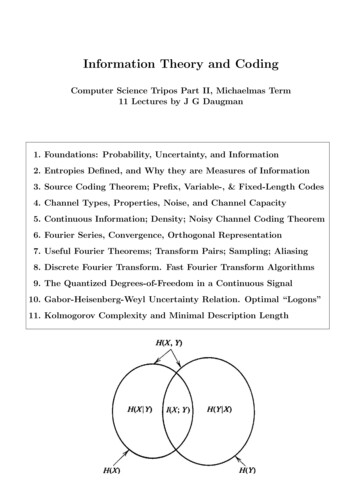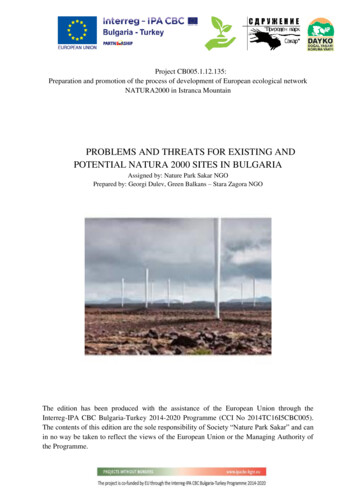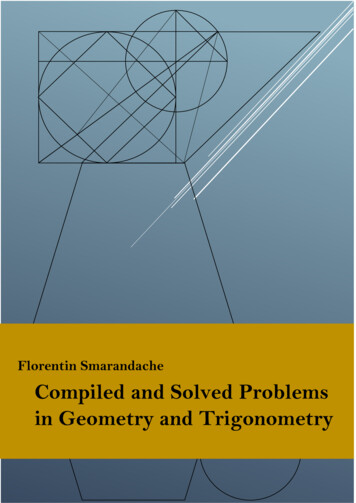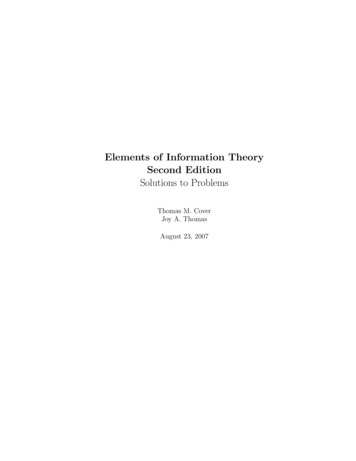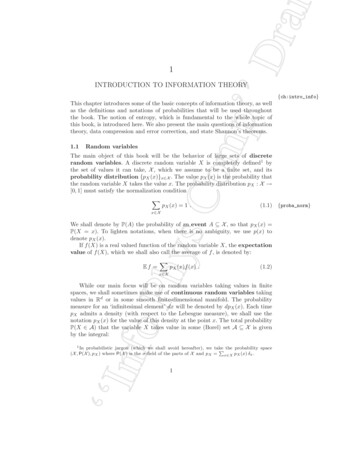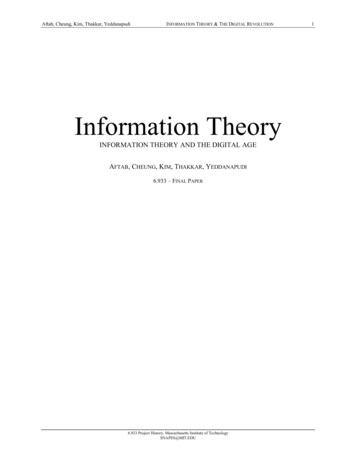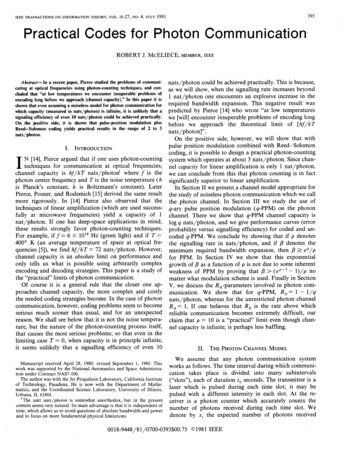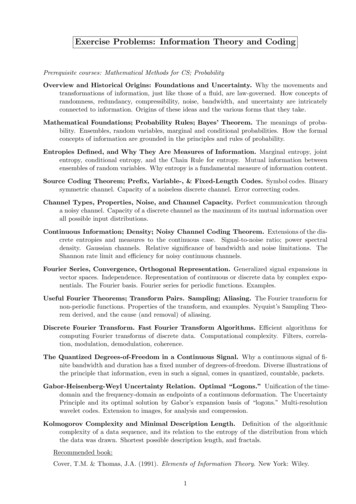
Transcription
Exercise Problems: Information Theory and CodingPrerequisite courses: Mathematical Methods for CS; ProbabilityOverview and Historical Origins: Foundations and Uncertainty. Why the movements andtransformations of information, just like those of a fluid, are law-governed. How concepts ofrandomness, redundancy, compressibility, noise, bandwidth, and uncertainty are intricatelyconnected to information. Origins of these ideas and the various forms that they take.Mathematical Foundations; Probability Rules; Bayes’ Theorem. The meanings of probability. Ensembles, random variables, marginal and conditional probabilities. How the formalconcepts of information are grounded in the principles and rules of probability.Entropies Defined, and Why They Are Measures of Information. Marginal entropy, jointentropy, conditional entropy, and the Chain Rule for entropy. Mutual information betweenensembles of random variables. Why entropy is a fundamental measure of information content.Source Coding Theorem; Prefix, Variable-, & Fixed-Length Codes. Symbol codes. Binarysymmetric channel. Capacity of a noiseless discrete channel. Error correcting codes.Channel Types, Properties, Noise, and Channel Capacity. Perfect communication througha noisy channel. Capacity of a discrete channel as the maximum of its mutual information overall possible input distributions.Continuous Information; Density; Noisy Channel Coding Theorem. Extensions of the discrete entropies and measures to the continuous case. Signal-to-noise ratio; power spectraldensity. Gaussian channels. Relative significance of bandwidth and noise limitations. TheShannon rate limit and efficiency for noisy continuous channels.Fourier Series, Convergence, Orthogonal Representation. Generalized signal expansions invector spaces. Independence. Representation of continuous or discrete data by complex exponentials. The Fourier basis. Fourier series for periodic functions. Examples.Useful Fourier Theorems; Transform Pairs. Sampling; Aliasing. The Fourier transform fornon-periodic functions. Properties of the transform, and examples. Nyquist’s Sampling Theorem derived, and the cause (and removal) of aliasing.Discrete Fourier Transform. Fast Fourier Transform Algorithms. Efficient algorithms forcomputing Fourier transforms of discrete data. Computational complexity. Filters, correlation, modulation, demodulation, coherence.The Quantized Degrees-of-Freedom in a Continuous Signal. Why a continuous signal of finite bandwidth and duration has a fixed number of degrees-of-freedom. Diverse illustrations ofthe principle that information, even in such a signal, comes in quantized, countable, packets.Gabor-Heisenberg-Weyl Uncertainty Relation. Optimal “Logons.” Unification of the timedomain and the frequency-domain as endpoints of a continuous deformation. The UncertaintyPrinciple and its optimal solution by Gabor’s expansion basis of “logons.” Multi-resolutionwavelet codes. Extension to images, for analysis and compression.Kolmogorov Complexity and Minimal Description Length. Definition of the algorithmiccomplexity of a data sequence, and its relation to the entropy of the distribution from whichthe data was drawn. Shortest possible description length, and fractals.Recommended book:Cover, T.M. & Thomas, J.A. (1991). Elements of Information Theory. New York: Wiley.1
Worked Example ProblemsInformation Theory and Coding: Example Problem Set 1Let X and Y represent random variables with associated probability distributions p(x) andp(y), respectively. They are not independent. Their conditional probability distributions arep(x y) and p(y x), and their joint probability distribution is p(x, y).1. What is the marginal entropy H(X) of variable X, and what is the mutual informationof X with itself?2. In terms of the probability distributions, what are the conditional entropies H(X Y ) andH(Y X)?3. What is the joint entropy H(X, Y ), and what would it be if the random variables X andY were independent?4. Give an alternative expression for H(Y ) H(Y X) in terms of the joint entropy andboth marginal entropies.5. What is the mutual information I(X; Y )?2
Model Answer – Example Problem Set 11. H(X) Xp(x) log2 p(x) is both the marginal entropy of X, and its mutual informa-xtion with itself.2. H(X Y ) H(Y X) 3. H(X, Y ) Xp(y)yXXxp(x)xyXXxXp(x y) log2 p(x y) p(y x) log2 p(y x) XXxXXxp(x, y) log2 p(x y)yp(x, y) log2 p(y x)yp(x, y) log2 p(x, y).yIf X and Y were independent random variables, then H(X, Y ) H(X) H(Y ).4. H(Y ) H(Y X) H(X) H(Y ) H(X, Y ).5. I(X; Y ) XXxor:XXxyp(x, y) log2yp(x, y) log2p(x, y)p(x)p(y)p(x y)p(x)or: I(X; Y ) H(X) H(X Y ) H(X) H(Y ) H(X, Y )3
Information Theory and Coding: Example Problem Set 21. This is an exercise in manipulating conditional probabilities. Calculate the probabilitythat if somebody is “tall” (meaning taller than 6 ft or whatever), that person must be male.Assume that the probability of being male is p(M ) 0.5 and so likewise for being femalep(F ) 0.5. Suppose that 20% of males are T (i.e. tall): p(T M ) 0.2; and that 6% offemales are tall: p(T F ) 0.06. So this exercise asks you to calculate p(M T ).If you know that somebody is male, how much information do you gain (in bits) by learningthat he is also tall? How much do you gain by learning that a female is tall? Finally, howmuch information do you gain from learning that a tall person is female?2. The input source to a noisy communication channel is a random variable X over thefour symbols a, b, c, d. The output from this channel is a random variable Y over these samefour symbols. The joint distribution of these two random variables is as follows:x a x b x c x dy a1811611614y b116181160y c1321321160y d1321321160(a) Write down the marginal distribution for X and compute the marginal entropy H(X) inbits.(b) Write down the marginal distribution for Y and compute the marginal entropy H(Y ) inbits.(c) What is the joint entropy H(X, Y ) of the two random variables in bits?(d) What is the conditional entropy H(Y X) in bits?(e) What is the mutual information I(X; Y ) between the two random variables in bits?(f ) Provide a lower bound estimate of the channel capacity C for this channel in bits.4
Model Answer – Example Problem Set 21. Bayes’ Rule, combined with the Product Rule and the Sum Rule for manipulating conditional probabilities (see pages 7 - 9 of the Notes), enables us to solve this problem.First we must calculate the marginal probability of someone being tall:p(T ) p(T M )p(M ) p(T F )p(F ) (0.2)(0.5) (0.06)(0.5) 0.13Now with Bayes’ Rule we can arrive at the answer that:p(M T ) (0.2)(0.5)p(T M )p(M ) 0.77p(T )(0.13)The information gained from an event is -log2 of its probability.Thus the information gained from learning that a male is tall, since p(T M ) 0.2,is 2.32 bits.The information gained from learning that a female is tall, since p(T F ) 0.06, is4.06 bits.Finally, the information gained from learning that a tall person is female, which requiresus to calculate the fact (again using Bayes’ Rule) that p(F T ) 0.231, is 2.116 bits.2. (a) Marginal distribution for X is ( 14 , 14 , 41 , 41 ).Marginal entropy of X is 1/2 1/2 1/2 1/2 2 bits.(b) Marginal distribution for Y is ( 12 , 41 , 18 , 81 ).Marginal entropy of Y is 1/2 1/2 3/8 3/8 7/4 bits.(c) Joint Entropy: sum of p log p over all 16 probabilities in the joint distribution(of which only 4 different non-zero values appear, with the following frequencies):(1)(2/4) (2)(3/8) (6)(4/16) (4)(5/32) 1/2 3/4 3/2 5/8 27/8 bits.(d) Conditional entropy H(Y X): (1/4)H(1/2, 1/4, 1/8, 1/8) (1/4)H(1/4, 1/2, 1/8,1/8) (1/4)H(1/4, 1/4, 1/4, 1/4) (1/4)H(1, 0, 0, 0) (1/4)(1/2 2/4 3/8 3/8) (1/4)(2/4 1/2 3/8 3/8) (1/4)(2/4 2/4 2/4 2/4) (1/4)(0) (1/4)(7/4) (1/4)(7/4) 1/2 0 (7/8) (1/2) 11/8 bits.5
(e) There are three alternative ways to obtain the answer:I(X; Y ) H(Y ) H(Y X) 7/4 - 11/8 3/8 bits. - Or,I(X; Y ) H(X) H(X Y ) 2 - 13/8 3/8 bits. - Or,I(X; Y ) H(X) H(Y ) H(X, Y ) 2 7/4 - 27/8 (16 14-27)/8 3/8bits.(f) Channel capacity is the maximum, over all possible input distributions, of the mutual information that the channel establishes between the input and the output.So one lower bound estimate is simply any particular measurement of the mutualinformation for this channel, such as the above measurement which was 3/8 bits.6
Information Theory and Coding: Example Problem Set 3A. Consider a binary symmetric communication channel, whose input source is thealphabet X {0, 1} with probabilities {0.5, 0.5}; whose output alphabet is Y {0, 1};and whose channel matrix is!1 ǫǫǫ1 ǫwhere ǫ is the probability of transmission error.1. What is the entropy of the source, H(X)?2. What is the probability distribution of the outputs, p(Y ), and the entropy of this output distribution, H(Y )?3. What is the joint probability distribution for the source and the output, p(X, Y ), andwhat is the joint entropy, H(X, Y )?4. What is the mutual information of this channel, I(X; Y )?5. How many values are there for ǫ for which the mutual information of this channel ismaximal? What are those values, and what then is the capacity of such a channel in bits?6. For what value of ǫ is the capacity of this channel minimal? What is the channel capacity in that case?B. The Fourier transform (whether continuous or discrete) is defined in the general casefor complex-valued data, which gets mapped into a set of complex-valued Fourier coefficients.But often we are concerned with purely real-valued data, such as sound waves or images, whoseFourier transforms we would like to compute. What simplification occurs in the Fourier domain as a consequence of having real-valued, rather than complex-valued, data?7
Model Answer – Example Problem Set 3A.1. Entropy of the source, H(X), is 1 bit.2. Output probabilities are p(y 0) (0.5)(1 ǫ) (0.5)ǫ 0.5 and p(y 1) (0.5)(1 ǫ) (0.5)ǫ 0.5. Entropy of this distribution is H(Y ) 1 bit, just as for theentropy H(X) of the input distribution.3. Joint probability distribution p(X, Y ) is!0.5(1 ǫ)0.5ǫ0.5ǫ0.5(1 ǫ)Xand the entropy of this joint distribution is H(X, Y ) p(x, y) log2 p(x, y)x,y (1 ǫ) log(0.5(1 ǫ)) ǫ log(0.5ǫ) (1 ǫ) (1 ǫ) log(1 ǫ) ǫ ǫ log(ǫ) 1 ǫ log(ǫ) (1 ǫ) log(1 ǫ)4. The mutual information is I(X; Y ) H(X) H(Y ) H(X, Y ), which we can evaluate from the quantities above as: 1 ǫ log(ǫ) (1 ǫ) log(1 ǫ).5. In the two cases of ǫ 0 and ǫ 1 (perfect transmission, and perfectly erroneous transmission), the mutual information reaches its maximum of 1 bit and this is also then the channelcapacity.6. If ǫ 0.5, the channel capacity is minimal and equal to 0.B. Real-valued data produces a Fourier transform having Hermitian symmetry: the realpart of the Fourier transform has even-symmetry, and the imaginary part has odd-symmetry.Therefore we need only compute the coefficients associated with (say) the positive frequencies, because then we automatically know the coefficients for the negative frequencies as well.Hence the two-fold “reduction” in the input data by being real- rather than complex-valued,is reflected by a corresponding two-fold “reduction” in the amount of data required in itsFourier representation.8
Information Theory and Coding: Example Problem Set 41. Consider a noiseless analog communication channel whose bandwidth is 10,000 Hertz.A signal of duration 1 second is received over such a channel. We wish to representthis continuous signal exactly, at all points in its one-second duration, using just a finitelist of real numbers obtained by sampling the values of the signal at discrete, periodicpoints in time. What is the length of the shortest list of such discrete samples requiredin order to guarantee that we capture all of the information in the signal and can recoverit exactly from this list of samples?2. Name, define algebraically, and sketch a plot of the function you would need to use inorder to recover completely the continuous signal transmitted, using just such a finitelist of discrete periodic samples of it.3. Consider a noisy analog communication channel of bandwidth Ω, which is perturbed byadditive white Gaussian noise whose power spectral density is N0 . Continuous signals aretransmitted across such a channel, with average transmitted power P (defined by theirexpected variance). What is the channel capacity, in bits per second, of such a channel?Model Answer – Example Problem Set 41. 2ωT 20,000 discrete samples are required.2. The sinc function is required to recover the signal from its discrete samples, defined as:sin(πx). Each sample point is replaced by scaled copies of this function.sinc(x) πx 3. The channel capacity is Ω log2 1 PN0 Ω 9bits per second.
Information Theory and Coding: Example Problem Set 5A. Consider Shannon’s third theorem, the Channel Capacity Theorem, for a continuous communication channel having bandwidth W Hertz, perturbed by additive white Gaussian noiseof power spectral density N0 , and average transmitted power P .1. Is there any limit to the capacity of such a channel if you increase its signal-to-noisePwithout limit? If so, what is that limit?ratioN0 W2. Is there any limit to the capacity of such a channel if you can increase its bandwidthW in Hertz without limit, but while not changing N0 or P ? If so, what is that limit?B. Explain why smoothing a signal, by low-pass filtering it before sampling it, can preventaliasing. Explain aliasing by a picture in the Fourier domain, and also show in the picturehow smoothing solves the problem. What would be the most effective low-pass filter to usefor this purpose? Draw its spectral sensitivity.C. Suppose that women who live beyond the age of 70 outnumber men in the same agebracket by three to one. How much informatio
Exercise Problems: Information Theory and Coding Prerequisite courses: Mathematical Methods for CS; Probability Overview and Historical Origins: Foundations and Uncertainty. Why the movements and transformations of information, just like those of a fluid, are law-governed. How concepts of



